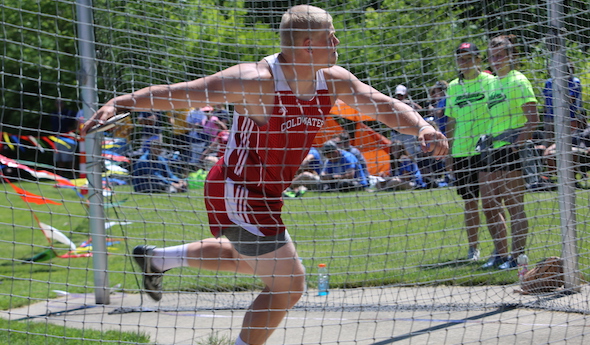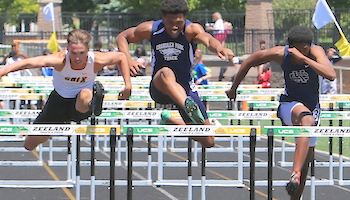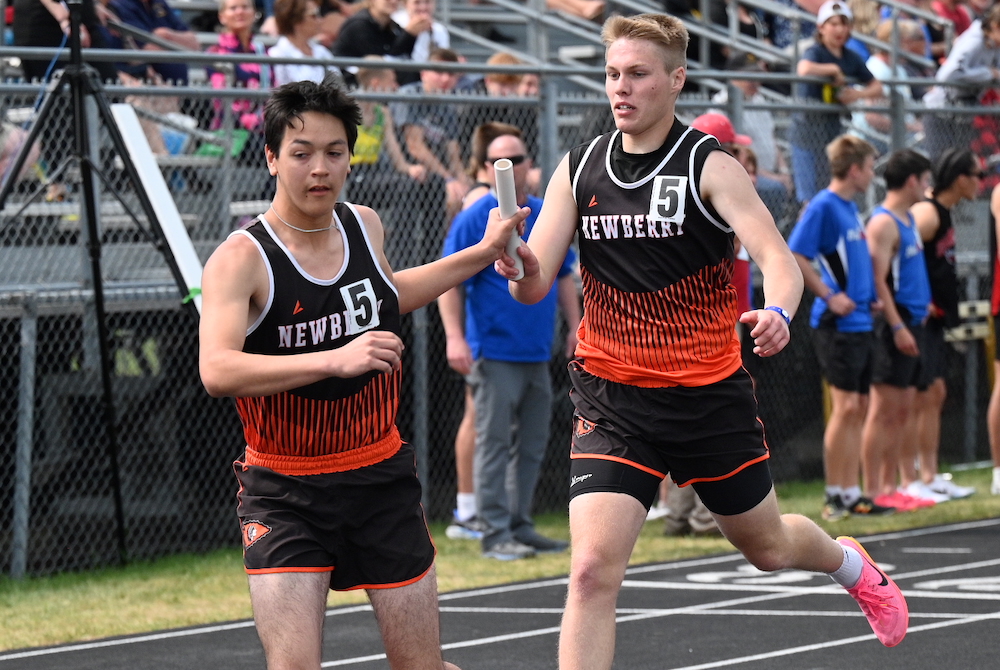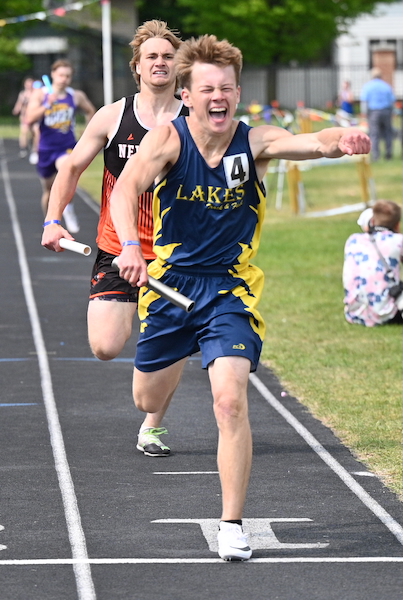
Coldwater Boys Trade Up for 1st Track Title
June 2, 2018
By Dan D’Addona & Tom Markowski
Special for Second Half
ZEELAND — Led by a trio of dominant throwers, the Coldwater boys track & field team had high hopes of winning the Lower Peninsula Division 2 Finals on Saturday.
The team finished runner-up to Zeeland East last year and returned most of its point scorers.
Coldwater turned the tables and surged to the championship this time with 60 points at Zeeland Stadium.
“It means a lot. We got second last year, and we were really happy with that,” Coldwater’s Dylan Targgart said. “But we have never done this in school history. It feels really good.”
Zeeland East was second with 53 points, followed by Harper Woods Chandler Park (37), Tecumseh (33), Chelsea (26), Saginaw (25), Flint Powers Catholic (21), Wyoming Lee (20), Essexville Garber (18) and Romulus (18).
Coldwater powered through the shot put, taking the top three places behind Dylan Targgart (61-2), Zach Gipple (54-0¼) and Cole Targgart (52-6¾).
“The energy is always there when we are in the ring, and that helps us a lot,” Dylan Targgart said. “It’s fun. After each person hits their throw, we build off of each other and off of the energy that the crowd is giving us.”
Zeeland East’s Boone Bonnema was fifth (52-1) in the shot put.
Dylan Targgart won the discus with a throw of 170 feet, 10 inches, holding off East’s Brenden Knoll (170-1).
Coldwater’s Shuaib Aljabaly added a win in the 1,600 in 4:16.56.
“Nobody remembers who finishes second,” Aljabaly said of 2017. “Finishing second last year was a big part of what we did today.”
Aljabaly placed second in the 3,200-meter run last season and said he needed to do more this season to help his team score points. He ran the 1,600 just a few times as a junior and made a concerted effort in this event to compete with the best.
“This year the mile was my best event,” he said. “I felt, in the shorter the race, the more guts you have to have. I wanted more of a challenge this year.”
Aljabaly placed third in the 3,200 and then, oddly, ran in the next and final race, the 1,600 relay and helped Coldwater finish seventh for two more points.
“It was great seeing everyone perform,” Targgart said.
Zeeland East’s Gabe Taylor, Alex Stockdale, Bryce Metzger and Corbin DeJonge won the 800-meter relay (1:29.67). The quartet also won the 400 (43.06).
DeJonge won the 300-meter hurdles in 38.14 for the Chix.
“My Regional time wasn’t very good, and I knew I had to do something different to try to win this, so I tried to bring it out way faster than I normally do, then try to have the crowd drag me through at the end,” DeJonge said. “It is tough because (the state title) as a team is what we were working toward.”
One of the more impressive athletes on this day was Thomas Robinson of Wyoming Lee. This was Lee’s first season competing at the Division 2 meet. Robinson won the 100 and 200 both of the last two seasons in Division 3, improving his times in both each time.
Robinson made it a double three-peat Saturday as he set personal bests in the 100 (10.85) and in the semifinals of the 200 (21.6). His winning time in the 200 was 21.62.
Robinson didn’t compete in track until his sophomore year, the same year he tried out for football. A 6-foot-1, 180-pound receiver, Robinson said he’s more of a fan in that sport than he is in track. Be that as it may, Robinson signed to run track at Michigan State.
“My football coach at the time told me I should go out for track,” he said. “He said it would make me better in football. I don’t like track as much as football. I’m just better at track.
 “I felt good running the 200. I am getting better. Just look at my times.”
“I felt good running the 200. I am getting better. Just look at my times.”
Like Robinson, Anthony Hudson of Harper Woods Chandler Park competed in football and track. And, like Robinson, Hudson began his high school career rather late. Hudson competed in track in middle school but decided not to compete as a freshman. He ran a couple of races as a sophomore before making a commitment his junior year. Last season he placed sixth in the long jump and was second in the 200. This season he won the 110 hurdles with a time of 14.68. He also placed fourth in the 200.
He held off Zeeland East’s DeJonge (14.69) by a hundredth of a second in the 110 in one of the closest races of the day.
“I didn’t think I’d be that good my freshman year,” he said. “That’s why I didn’t come out.”
Hudson signed to play football at Davenport University and said he might try both sports if he can handle the load. He plans on majoring in sports management in college.
Chances are not many in the crowd expected Jacob Denison of Tecumseh to do well in the 400 run. That’s all right. Denison followed his own expectations.
The junior won the 400 with a time of 49.27, a personal best. Last season he competed in one event, the 1,600 relay. Denison also ran on the 400 and 800 relays this season.
“I’ve been working hard all season for this,” he said. “It’s not much of a surprise to me. It was just a lot of hard work. I knew I had to take it out fast today. I had a good coach who got me out of the block faster, and I had a lot of support from my family. I’m blessed.”
Injuries held Alex Comerford back last season as the junior from Otsego placed 11th in the 3,200. Healed by the time fall rolled around, Comerford placed second at the Cross Country Finals and won the 3,200 on Saturday with a time of 9:07.25.
“It’s something I’ve been working on,” he said. “I haven’t been finishing well, and it was really my cross country season that started things. I got stronger. I grew up.”
In the 3,200-meter relay, Chelsea’s Connor Gilbreath, Jensen Holm, Carson Rabbitt and Tom Oates won in 7:56.48, holding off Zeeland West’s Carson Holwerda, Bryce Arredondo, Lunke Munsey and Matthew Converse (7:59.93).
Parma Western’s Alex Inosencio won the pole vault in 15-8, besting the field by an entire foot. Lake Fenton’s Jaden Zaitshik won the high jump in 6-7, and Saginaw’s Tony Martin won the long jump in 22-7.
Essexville Garber’s Josiah Morse won the 800 (1:55.63), and Lansing Catholic’s Ryan Schroeder, James Fedewa, Jack Fedewa and Ryan Ruiter won the 1,600 relay (3:23.27).
VIDEO: Coldwater's Shuab Aljabaly wins the 1,600.
VIDEO: Oak Park's Donnie James sets a meet record in the 200.
PHOTOS: (Top) Coldwater's Zach Gipple begins to unwind on a discus toss Saturday. (Middle) Chandler Park's Anthony Hudson, middle, stays just ahead of Zeeland East's Corbin DeJonge, left, in the 110 hurdles, which proved to be the closest race of the meet. (Photos by Janina Pollatz. Click for more from RunMichigan.com.)

Newberry Clinches 1st Track & Field Finals Repeat in 2 Decades
By
John Vrancic
Special for MHSAA.com
June 1, 2025
KINGSFORD — Nearly two decades ago, the Newberry boys became Upper Peninsula Division 2 track & field champs in back-to-back years.
They accomplished the same here Saturday, retaining their Division 3 title with 84 points, Runner-up Lake Linden-Hubbell scored 73, with Bessemer a surprising third at 46.
“We kind of did what we had all season,” Newberry coach Drew Schultz said. “We were kind of top heavy. We were lacking depth a little, but I knew if the guys did what they did all season, I liked our chances. This is the first time we won back-to-back years since I was in high school (2005-06). This is fun, bringing four championship trophies back to the eastern U.P. Pickford’s kids did a nice job (sweeping titles) in D-2.”
Newberry started this day on a positive note, winning the 3,200-meter relay in a season-best 8:42.67.
Senior Connor Carlson, who anchored that relay, also placed fourth in the 200 (24.31) and 400 (54.07).
“It feels good to win,” he said moments after finishing the relay. “I love winning. Garrett (Lewicki) ran a great first leg. Everyone was rolling. This sets the tone pretty good.”
Lewicki also anchored the 1,600 relay which placed second (3:42.47), and took third in the open 800 (2:09.83).
Newberry senior Matt Rahilly won long jump at 20-4½ and high jump (6-0), placed second in the 100 (11.51) and third in the 200 (24.24). Classmate Ethan Pavey added a first in shot put (43-6½).
Senior Dakota Taylor, who will run cross country at North Central Michigan College in Petoskey this fall, provided Engadine with a solid showing. He took second in the 3,200 in a personal-best 10:20.96 and third in the 1,600 (4:51.61), and helped the Eagles place fourth in the 3,200 relay (9:08.59).
Brimley swept the sprint relays, taking the 400 (46.78) and 800 (1:36.75), and senior Adrian Kunowski took pole vault (11-1).
“I’d say our handoffs went well,” Brimley sophomore Gus Vonseggem said. “We didn’t qualify last year. Cooper (Jones) and Trey (Lynn) joining the team made a difference. We really wanted to break the school record. We still need to make our handoffs a little better. It takes a lot of offseason work. Overall, we’re happy with the team’s performance.”
Chassell senior and Michigan Tech recruit Kalvin Kytta was a triple-winner, taking the 800 at 2:03.71, 1,600 in a personal-best 4:28.58 and 3,200 (10:11.42).
“I’m very happy with my season,” he said. “I was going for the record in the 3,200, but just couldn’t quite get that today. The PR (personal record) in the mile was kind of a reflection win.
“Glory to God for sure. He gives me the strength to do all this. I’m getting to know the guys a little at Tech. I’m thankful to God for providing me with this opportunity.”
Lake Linden-Hubbell sophomore Lukas Axford captured the 300 hurdles (42.46) and anchored the winning 1,600 relay (3:41.89). Watersmeet senior Thomas Caron was a double winner, taking the 200 (23.91) and 400 (52.36) and adding a fourth in the 100 (11.75).
Bessemer senior Bryce Martin won the 100 (11.44), and sophomore Jayden Verrett was runner-up in the 200 (23.92), third in the 100 (11.52) and anchored two second-place sprint relays.
PHOTOS (Top) Newberry's Garrett Lewicki hands off the baton to Danny Mikus during the 1,600 relay Saturday. (Middle) Lake Linden-Hubbell's Lukas Axford celebrates his team's win in that race. (Click for more from Cara Kamps/RunMichigan.com.)

